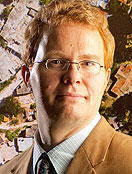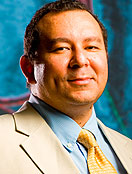News
UB faculty on panels studying
state response to natural disasters
Two UB experts will be doing important work on commissions analyzing how New York State can strengthen its response to natural disasters like Hurricane Sandy, which destroyed homes through wind, flood and fire, and left millions of people without electricity, transportation and other critical services for days or weeks.
The faculty members are Chris Renschler, associate professor of geography, and Adel Sadek, professor of civil, structural and environmental engineering. Both are faculty members in MCEER, UB’s extreme events engineering research center, and on the faculty advisory committee of the UB 2020 Strategic Strength in Extreme Events: Mitigation and Response.
Renschler has been appointed as a member of NYS Respond, a commission that will make recommendations for how the state can better deploy people and resources during natural disasters, and especially after a weather-related emergency.
Among other topics, NYS Respond will look at disaster-information communication, one of Renschler’s areas of expertise. He was appointed to the commission because of his research on providing timely and reliable information in extreme events, and helping officials and the public to rapidly identify and meet such needs as shelter, food, water, electricity and essential appliances.
Sadek serves on a subcommittee of the NYS 2100 Commission that is “tasked with finding ways to improve the resilience and strength of the state’s infrastructure in the face of natural disasters and other emergencies,” according to Gov. Andrew Cuomo’s office.
Renschler, director of UB’s Landscape-based Environmental System Analysis and Modeling lab (LESAM), has studied and responded to a number of disasters, helping decision-makers obtain emergency data quickly and efficiently.
Following Hurricane Sandy and the Haiti earthquake in 2010, he and his students used aerial imagery to assess how individual structures were damaged. This project gave disaster responders a clear and rapid picture of which neighborhoods were hardest hit.
After Hurricane Irene in 2011, Renschler collected aerial imagery and topographic data of the flooded areas and led a LESAM/MCEER research team that visited communities in the Schoharie Creek watershed west of the Catskill Mountains to document flood damage.
Renschler’s work on Irene, Sandy and the Haiti quake was supported or facilitated by the Information Products Laboratory for Emergency Response (IPLER), a National Science Foundation-funded Partnership for Innovation project headed by the Rochester Institute of Technology (RIT) and UB. Renschler is a co-principal investigator of the project, whose activities include developing technologies that can provide emergency responders with real-time damage assessments during disasters.
“I am honored to serve on the governor’s commission to contribute to enhancing the functionality of a rapid and reliable flow of critical information for decision-makers, including emergency responders, utility managers and impacted individuals,” Renschler said.
Sadek, director of UB’s Transportation Systems Engineering Lab, serves as chair of UB 2020’s Strategic Strength in Extreme Events. His research focuses on traffic, which includes everything from air pollution at border crossings to creating the best evacuation routes during emergencies.
The NYS 2100 Commission subcommittee on which he sits consists of roughly a dozen “SUNY experts” and was formed by Timothy Killeen, SUNY vice chancellor for research and president of the SUNY Research Foundation.
The subcommittee’s immediate job, Sadek said, is to review all reports related to the state’s infrastructure, find any gaps in knowledge that need to be addressed and make recommendations that will improve the state’s bridges, tunnels, roads and other infrastructure.
“Our task is to help make sure that transportation infrastructure is more resilient in cases of extreme events like Hurricane Sandy,” said Sadek, who studies the use of new technologies, such as collision-avoidance systems, adaptive traffic control and dynamic route guidance to increase safety and efficiency.
NYS Respond and NYS 2100 are two of three disaster-preparedness and response commissions that Cuomo’s office announced on Nov. 28. Recommendations are due to the governor by Jan. 3. For details on all the commissions and a list of appointees, click here.



Reader Comments